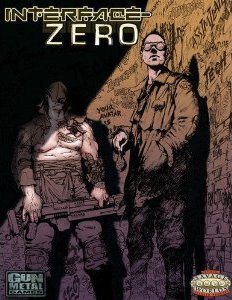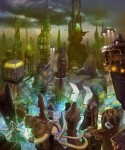Interface Zero
Interface Zero is a complete setting for Savage Worlds (with editions for True20 and d20 Modern) and published by Gun Metal Games.
By David Jarvis

Welcome to the sixteenth Designer’s Diary, a regular column where designers are given the opportunity to take readers on an in-depth ride through the design and development process of their system, setting, or product.
Designer’s Description
There’s no real simple way to encapsulate Interface Zero, to be honest with you, because Interface Zero is many things. More accurately, it has the POTENTIAL to be many things. The “canned” response is that Interface Zero is a cyberpunk game setting that takes place in the year 2088. But it’s much more than just cyberpunk. At its core, IZ (Interface Zero for short) is a science fiction setting which embraces many elements that are common in cyberpunk and all the genre’s incarnations, e.g. shiropunk, post-apocalyptic anime, transhumanism, dystopic future science fiction, pot-cyberpunk, etc. In some ways, Interface Zero is a toolkit you can use to create the cyberpunk game you want to play, adding or dropping the elements to create your own vision of the world as it exists in 2088.
Don’t like Psionics? no worries, drop them. Think Hybridization is a bit too strange for your tastes? No problemo’. Just disallow that race option, and you don’t have to deal with it. Maybe you like having mecha in a futuristic world reminiscent of Appleseed, Gundam, or Bubblegum Crisis? We’ve got you covered there too. Wanna do a road-warrior/cyberpunk hybrid game, or play in a futuristic MMORPG of your favorite fantasy role-playing game or wild west game? You can do that as well! Interface Zero really has no boundaries where “near-future” sci-fi is concerned. You can even play games that take place on Mars, or mining colonies on an asteroid, or even on settlements on Europa, Ganymede or Callisto.
Purpose
I could probably give you a ton of reasons why we did IZ, but there’s only one that matters- Love. Everyone who was involved in the development of Interface Zero (and everyone who is currently involved in supporting it) loves cyberpunk, and wanted to create a setting that reflected that love of the genre.

Influences
Keep in mind, I’m only one person out of a number of people who were involved in this project. That said, I was heavily inspired by Blade Runner, the Shadowrun and (surprisingly to a lesser extent) Cyberpunk RPGS, and of course, all things William Gibson; Neuromancer, Count Zero, Mona Lisa Overdrive, Snow Crash, the Dark Angel TV show, Minority report, and a ton of Anime like Appleseed, Bubblegum Crisis, Cowboy Bebop and Ghost in the Shell were also big inspirations. But that’s really only scratching the surface. As I said, I’m only one small part of the team who originally created IZ.
Research
I’d have to say that when writing and developing a futuristic science fiction setting, research plays into it, but not so much as you might think. Interface Zero was more speculative than it was based on any hard science. That said, there were subjects we tackled, like computing and the creation of The Deep, where we wanted to be sure we were getting it right, or at least modernizing the science in comparison to other cyberpunk games. For instance, The Deep is wireless and based on concepts like cloud computing, and Hyper Reality is actually starting to work its way into today’s wireless devices thanks to GPS, just do a google search on “Augmented Reality,” and you’ll see what I’m talking about.

Art Direction
The artwork you’ll find in Interface Zero and it’s supplements tries to capture the edgy feel of the game. In the core book, I decided to go with black and white throughout, but in the supplements I’m going for color in the electronic versions(PDFs) and greyscale for print.
I think the artwork helps readers to better relate to some of the more abstract concepts in the game, such as The Deep. beyond that, though, I’ve always like to put artwork in my books, and I’ve had fun taking write-ups for some of the equipment and vehicles and getting some cool illustrations of them.

Gaming Experience
Interface Zero was designed to provide players and GMs with the tools they need to have a fun, cyberpunk game session. Now, you might be asking yourself “What does that mean?” Well, it really depends on what YOU think cyberpunk games are supposed to be like. Some people want non-stop over-the-top action. Others want to get into a noir-inspired game, or blast their way through cities in mecha, or raid corporate arcologies. Others like street level investigations, or gritty rules to reflect a dystopian game. Interface zero provides all of that, but let’s YOU choose what’s right for your game.
Comparison
I don’t like to compare my games to others, out of respect to the developers of those games. Sorry.

Development Process
The development process for our games is pretty straight forward. I’ll brainstorm with the writer or writers (as the case may be) for as long as it takes to flesh out their ideas for a game or supplement, then set them to work writing it. As writing progresses, we have regular meetings, usually via email or on the phone, and we discuss any issues that might be coming up. I offer what insights I can and let them do what they do best… write. Editing is essentially the same thing, but I don’t usually involve myself directly in that process, preferring to let the editors and writers work together to fix any issues. During this time, I’m starting to look for artists which I feel will bring key concepts of the game to life. I start getting maps done, if any are needed, and work on getting a graphic design for the book’s interior. After editing and any play testing is finished, I begin layout.


